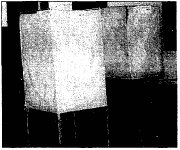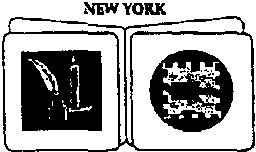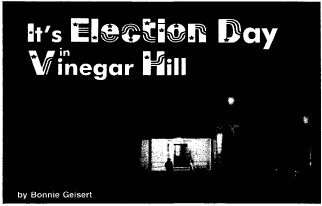This is what a voting booth looks like.
The judges have officiated over several electionsŌĆöone judge since 1962. In a friendly wager, each estimates the number of people who will vote. During the March 1996 general primary election, the guesses were 24, 25, 30, 31, and 33. The actual turnout was 28, including 1 absentee voter.
Voters arrive throughout the day. Sometimes there is a ŌĆ£rushŌĆØ during the noon hour, a natural break for farmers. ŌĆśWhen each voter enters a booth, he or she inserts the ballot into the machine and punches the stylus (a sharp, pointed instrument) through the desired choices. When finished, the voter hands the ballot to a judge. The judge then places it in the ballot box after making sure his or her initials are on the ballot.
At 6:30
P.M.,
a judge announces, ŌĆ£The polls will close in one-half hour.ŌĆØ At 7:00 P.M., the polls close.
.
After closing the doors, the judges open the varnished wooden ballot box and check the ballots to make sure the little punched paper pieces, called chads, have been removed so that the vote-counting machine at the county courthouse can read the ballots. After filling
Ę
out the required forms, the judges place the completed ballots and documentation in the ballot transfer case and seal the case. They pack the vote-recording machines in their cardboard box and place all the other materials in the election supply case. Then they turn down the thermostat, shut off the lights, and leave the Town Hall between 7:30 and 8:00
P.M.
One judge from each party accompanies the cases to the courthouse, where the votes are counted by machine in a matter of seconds. The judges are paid $65 for the day plus $15 for attending a training session, $5 for picking up the election materials, and $5 for returning them. The driver receives 30 cents per mile.
Back to top
Go On
Back to top
Page T-5
the voters
the
voters
U
A
C
What is the authorŌĆÖs main purpose in writing the article?
What is the authorŌĆÖs main purpose in writing the article?
A to describe the election practices of a rural town
B to outline requirements for election judges in Illinois
C to show that voting practices are too complicated
D to explain how election officers are paid
Which statement is true of ALL elections in Vinegar Hill?
Which statement is true of ALL elections in Vinegar Hill?
F Eighty percent of the voters in the area will vote.
G Most of the voters arrive in the early morning.
H The township supervisor is present at all times.
J Election judges swear to support the Constitution.
From which of these groups are the election judges selected?
From which of these groups are the election judges selected?
A employees of the township
B elected officials
C local citizens who have been trained
D volunteers from both political parties
One Vinegar Hill election practice is to place the completed ballots in a transfer case and seal the case. What purpose does this practice serve?
F It maintains privacy for voters.
G It conceals the number of citizens who have voted.
H It reduces the election judgesŌĆÖ workload.
J It keeps all of the election materials together.
Who
sets up the
voting-room furniture before election day?
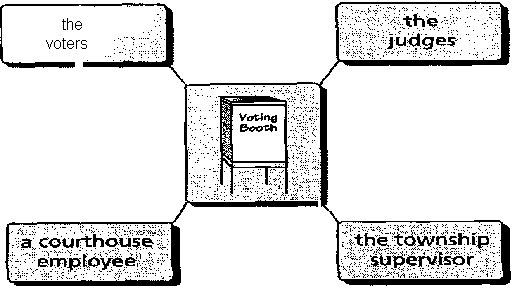
The judges at Vinegar Hill open the polls at 6 A.M. because
F
it is the official opening time
G
it allows them to close early
H
that is the best
time for the judges
J
that is the best time for farmers
On election day the final vote count is made
On election day the final vote count is made
A
at the county courthouse
B
in the last hour of voting
C
by the election judges
D
no later than 8
p.~.
When the author states that ŌĆ£the judges have officiated
over several elections, she means that the judges have
F
watched the voting procedure
G
carried out election duties
H
counted the absentee ballots
J
estimated voter percentages
Go On
D
Back to top
irections
Here is a story from India about a tiger and the family who raises it. Read ŌĆ£The Day Grandfather Tickled a Tiger.ŌĆØ Then do Numbers 9 through 18.
The Day
Grandfather
Tickled a Tiger
a true story by Ruskin Bond
T
imothy, our tiger cub, was found by my grandfather on a hunting expedition in the Terai jungles near Debra, in northern India. Because Grandfather lived in Dehra and knew the jungles well, he was persuaded to accompany the hunting party.
Grandfather, strolling down a forest path some distance from the main party, discovered a little abandoned tiger about eighteen inches long, hidden among the roots of
a banyan tree. After the expedition ended, Grandfather took the tiger home to Debra, where Grandmother gave him the name Timothy.
TimothyŌĆÖs favorite place in the house was the living room. He would
snuggle down comfortably on the sofa, reclining there with serene dignity and snarling only when anyone tried to take his place. One of his chief amusements was to stalk whoever was playing with him, and so, when I went
to live with
my grandparents, I became one of the tigerŌĆÖs pets. With a crafty look in his eyes, and his body in a deep crouch, he would creep closer and closer to me, suddenly making a dash for my feet. Then, rolling on his back and kicking with delight, he would pretend to bite my ankles.
By this time he was the size of a full-grown golden retriever, and when I took him for walks in Debra, people on the road would give us a wide berth. At night he slept
in the quarters of our cook, Mahmoud. ŌĆ£One of these days;ŌĆÖ Grandmother
declared, ŌĆ£we are going to find Timothy sitting on MabmoudŌĆÖs bed and no sign of
Mahmoud!ŌĆØ
When Timothy was about six months old, his stalking became more serious
and he had to be chained up more frequently. Even the household started to
mistrust him and, when he began to trail Mahmoud around the house with what
looked like villainous intent, Grandfather decided
it was time to transfer
Timothy to a zoo.
The nearest zoo was at
Lucknow, some two hundred miles away. Grandfather reserved a first-class compartment on the train for himself and Timothy and pleased to receive a well-fed and fairly civilized tiger Grandfather had no opportunity to see how
Timothy was getting on in his new home until about six months later, when he and Grandmother visited relatives in Lucknow. Grandfather went to the zoo
and directly to TimothyŌĆÖs cage. The tiger was there, crouched in a corner, full-grown, his magnificent
striped coat gleaming with health.
ŌĆ£Hello, Timothy,ŌĆØ Grandfather said.
.
Climbing the railing, he put his arms through the bars of the cage. Timothy approached, and allowed Grandfather to put both arms about his head. Grandfather stroked the tigerŌĆÖs forehead and tickled his ears. Each time Timothy growled, Grandfather gave him a smack across the mouth, which had been his way of keeping the tiger quiet when he lived with us.
Timothy licked GrandfatherŌĆÖs hands. Then he showed nervousness, springing away when a leopard in the next cage snarled
at him ,but Grandfather
shooed the leopard off and Timothy returned to
licking his hands. Every now and then the leopard
would rush at the bars, and Timothy would again
slink back to a neutral corner.
A number of people had gathered to watch the
reunion, when a keeper pushed his way through the crowd and asked Grandfather what he was doing. ŌĆ£IŌĆÖm talking to Timothy:ŌĆÖ said Grandfather. ŌĆ£WerenŌĆÖt you here when I gave him to the zoo six months ago?ŌĆØ
keeper. ŌĆ£Please continue your conversation. I have never been able to touch
that tiger myself. I find him
very bad-tempered?ŌĆÖ
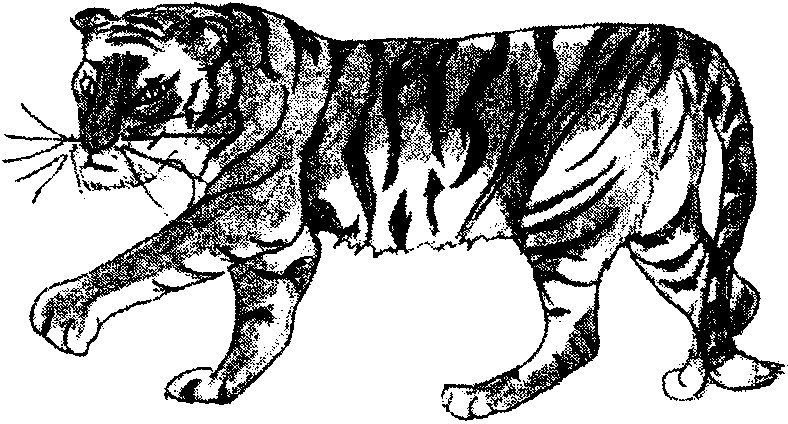
Grandfather had been stroking and slapping Timothy for about five minutes when he noticed another keeper observing him with some alarm. Grandfather recognized him as the keeper who had been there when he had delivered Timothy to the
zoo.
ŌĆ£You
remember me:ŌĆÖ said Grandfather, ŌĆ£Why donŌĆÖt you transfer Timothy to a different cage, away from this stupid leopard?ŌĆØ
ŌĆ£ButŌĆösirŌĆÖ stammered the keeper. ŌĆ£It is not your tiger!ŌĆÖ
ŌĆ£I realize that he is no longer mine,ŌĆØ said Grandfather testily.ŌĆØ But at least take my suggestion?ŌĆÖ
ŌĆ£I remember your tiger very well;ŌĆÖ said the keeper.
ŌĆ£He died two months ago.ŌĆØ
ŌĆ£Died?ŌĆÖ exclaimed Grandfather.
ŌĆ£Yes, sir, of pneumonia. This tiger was trapped in the hills only last month, and he is very dangerous!ŌĆØ
The tiger was still licking GrandfatherŌĆÖs arms and
apparently enjoying
it more all the time. Grandfather
withdrew his hands from the cage in a motion that seemed to take an age. With his face near the tigerŌĆÖs he mumbled, ŌĆ£Goodnight, Timothy?ŌĆÖ Then, giving the keeper a scornful look, Grandfather walked briskly
out of the zoo.
Session 1
Session 1

This story is mostly about how
A to train a wild tiger
B to capture a wild tiger
C wild animals are cared for in zoos
D a wild tiger seems tame when treated kindly
Why did Grandfather bring Timothy home to Dehra?
F to rescue an orphan cub
G to sell the tiger to the zoo
H to give his grandson a pet
J to guard his home and family
What change causes Grandfather to take Timothy to the zoo?
A There is a rapid increase in TimothyŌĆÖs size.
B The people in Dehra become fearful.
C Grandfather no longer has time for the tiger.
D TimothyŌĆÖs behavior becomes threatening.
Why are the zoo authorities glad to take Timothy?
F The previous tiger had died of pneumonia.
G A tiger from the Terai jungles attracts many visitors.
H The tiger is healthy and has been raised in captivity.
J They needed another tiger to keep the leopard in the next cage
company.
Why does it take Grandfather so long to visit Timothy at the zoo?
A He wants Timothy to have time to settle in.
B The zoo is too far away for frequent visits.
C Seeing Timothy is a cage makes him sad.
D Visiting the tiger is discouraged by zoo authorities.
Why does the tiger become nervous during GrandfatherŌĆÖs visit to the zoo?
Why does the tiger become nervous during GrandfatherŌĆÖs visit to the zoo?
F There is a crowd of people watching.
G The leopard in the next cage keeps snarling.
H He doesnŌĆÖt like Grandfather slapping him when he growls.
J The zookeeper outside the cage keeps talking to them.
Why is Grandfather able to stroke the tiger and tickle his ears, while the zookeeper is afraid to touch the tiger?
A The tiger does not like the zookeeper.
B The tiger recognizes Grandfather.
C Grandfather treats the tiger with familiarity and firmness.
D The zookeeper makes the tiger nervous and uncomfortable.
What is surprising about the end of the story?
What is surprising about the end of the story?
F Grandfather learns he has been petting a wild tiger.
G Timothy recognizes Grandfather after not seeing him for months.
H The zookeeper cannot pet the tiger, but Grandfather can.
J The leopard and the tiger become friends.
When the narrator says that he and Timothy walked together in Dehra and people gave them a wide berth, what does he mean?
A People acted surprised.
B People looked on curiously.
C People kept their distance.
D People stared rudely.
Timothy snuggled down on the sofa, ŌĆ£reclining there with serene dignity and snarling only when anyone tried to take his place.ŌĆØ The word serene means
F angry
G fake
H quiet
J excited
D
Back to top
irections
Here is an essay from Charles OsgoodŌĆÖs book The Osgood Files. Now read ŌĆ£The Hard Part.ŌĆØ Then do Numbers 19 through 25.
The Hard Part
by Charles Osgood
I have been asked to deliver commencement addresses at two different educational institutions this year. One is a full-fledged university in upstate New York, and the other is a grammar school1 about a block and a half from my house in New Jersey. I have thought about delivering exactly the same address to both graduating classes, even though the average age of one class will be twenty-one, and the average age of the other will be eleven. That is because what I have to say will be just as understandable to one group as it will to the other. What I want
to say will be something like this:
It has been a very long time since I was twenty-one years old, and an even longer time since I was eleven, but I can remember both ages pretty well. When I
was eleven, I was quite worried, because everybody told me that junior high school2 was going to be quite a bit more difficult than grammar school had been. From the seventh grade on, I had been warned, life would be real and earnest.
It turned out that junior high wasnŌĆÖt so tough after all, but I knew full well,
because everybody told me, that high school would be quite another matter. Much more would be expected of me in high school, I was sure, and I was plenty worried about
it, too. But
it turned out to be nowhere near as bad as I had feared.
However, there was no question that college would be difficult in the extreme. Colleges and universities would separate the men from the boys, and the women from the girls, I was informed. Well, I donŌĆÖt know about that, but at my college they did separate the boys from the girls and the men from the women. But the work still didnŌĆÖt seem as oppressive as advertised.
Still ahead of me lay other prospects: The military, which would straighten me out in a hurry, graduate school, which would be murderously difficult, or something called the ŌĆ£real world?ŌĆÖ In the ŌĆ£real world:ŌĆÖ you would have to go out and
get a real job and do actual work.
1grammar school: elementary school
2junior high school: middle school
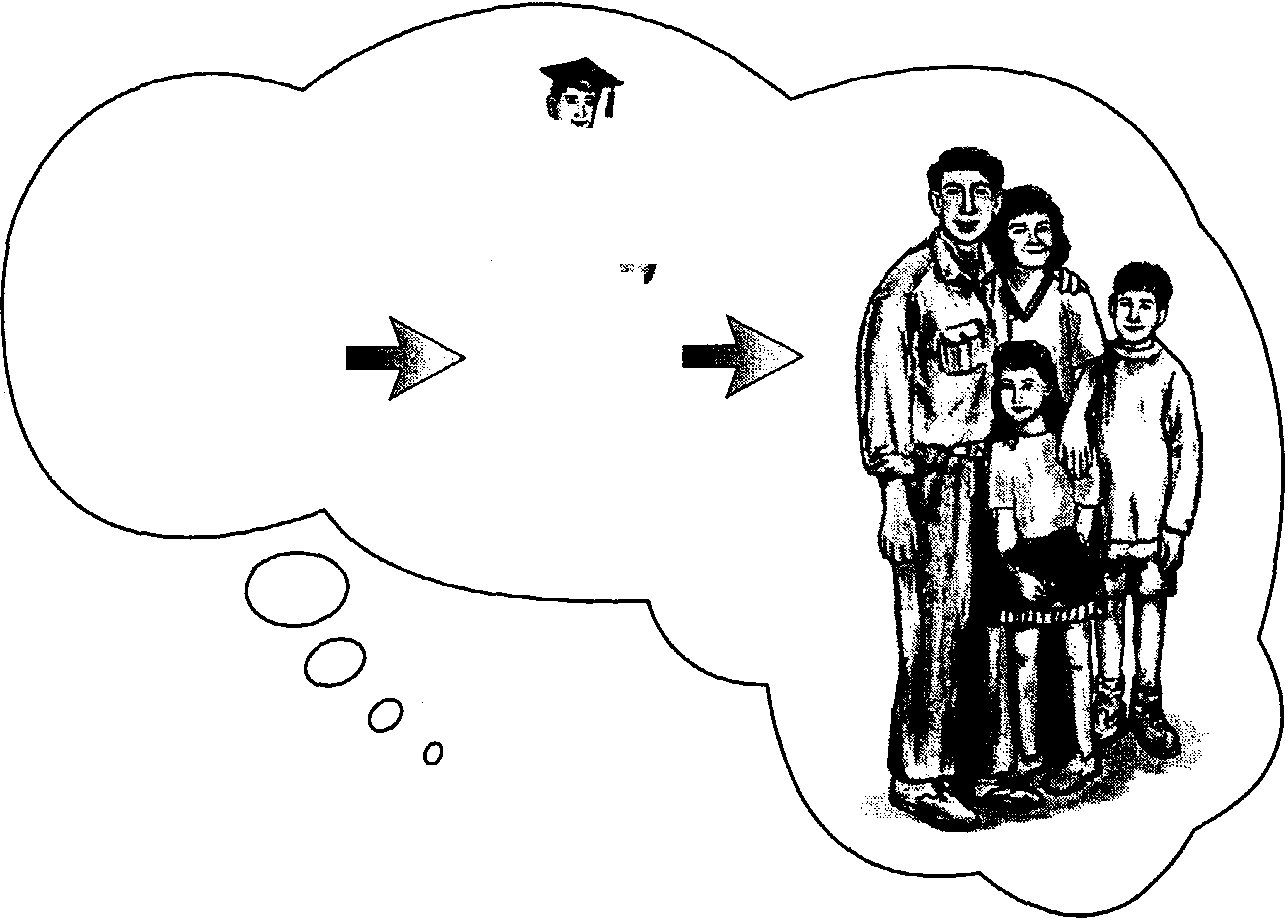


In the army, it turned out, I was assigned to the
U.S.
Army Band. It was a dirty job, but somebody had to do it. Since then
I
have been working in the broadcasting business. At the local station they said it would be much harder work at the network. In radio they said it would be far more demanding in television. Turns out all of it is interesting work with hardly any heavy lifting or drudgery involved. In other words, I never did have to get a ŌĆ£realŌĆØ job or do ŌĆ£actualŌĆØ work.
When I was single, everybody said life gets tough after you get married. Then they told me having kids and family responsibilities and owning a home and paying taxes would wear me down. HasnŌĆÖt happened yet.
Life is earnest, life Is real,
Up to the very end.
And the hard part, everybody says,
Is just around the bend.
But hereŌĆÖs a little secret that I want to share with you.
What is true for other people, need not be the case for you.
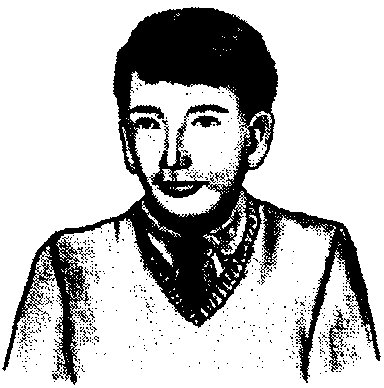
When they tell you that the hard pan starts in just a little while,
Look worried,
if
you want to, but inside of you, just smile.
Session 1
Session 1
Back to top
Page T-13

What advice does the author give in this essay?
What advice does the author give in this essay?
A Prepare for the next step in life.
B Find the best work that life offers.
C Learn from the experience of others.
D Keep an open mind about new experiences.
Which statement from the essay provides the strongest arguments for following the authorŌĆÖs advice?
F ŌĆ£It was a dirty job, but somebody had to do it?
G ŌĆ£What is true for other people, need not be the case for you.
H ŌĆ£In the ŌĆśreal world; you would have to go out and get a teal job and do actual work?ŌĆÖ
J
ŌĆ£Turns out all of it is interesting work with hardly any heavy lifting or drudgery involved!ŌĆÖ
How do the authorŌĆÖs views seem to differ from those of the other people in his life?
A He thinks marriage is more difficult than work.
B He views life with a more positive attitude than others do.
C He thinks junior high is more difficult than college.
D He believes work is less important than other people do.
According to other people, what purpose would college serve for the author?
According to other people, what purpose would college serve for the author?
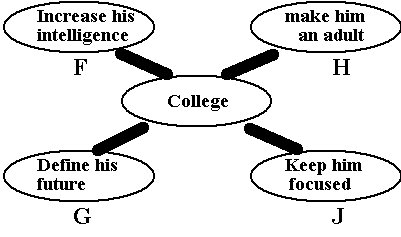
How did the author manage to avoid hard work throughout his life?
A He found jobs that were easy.
B He enjoyed the different kinds of work he did.
C He got other people to do his work for him.
D He convinced his bosses that the work was
What is the most likely reason the author has included the poem in his essay?
What is the most likely reason the author has included the poem in his essay?
F to emphasize his message
G to reveal another of his talents
H to warn the reader of troubles ahead
J to remind the reader to greet people with a smile.
The author did not find the work at college to be oppressive. What does oppressive mean?
A attractive B exciting C unsatisfying D overwhelming
Back to top
Directions
In this part of the test, you will listen to two essays: ŌĆ£Shi-ma-sani and Shi-cheehŌĆØ by Peggy Yazzie and ŌĆ£Gone ForeverŌĆØ by Buffalo Bird Woman. Then you will answer some questions to show how well you understood what was read.
You will listen to the essays twice. The first time you hear the essays, listen carefully but do not take notes. As you listen to the essays the second time, you may want to take notes. You may use these notes to answer the questions that follow. Use the space below and on the next page for your notes.
Here are some words and definitions you will need to know as you listen to the essays:
ŌĆ£Shi-ma-sani and Shi-cheehŌĆØ
ŌĆ£Shi-ma-sani and Shi-cheehŌĆØ
- Shi-ma-sani grandmother
- Shi-cheeh grandfather
- hogan earth-covered Navajo dwelling
- hand-tremble hand-motion used in Native American religious ceremonies
ŌĆ£Gone ForeverŌĆØ
ŌĆ£Gone ForeverŌĆØ
- Hidatsa a Native American tribe
Back to top
Notes
Back to top
Notes
Using specific details from the essay, complete the chart below to show what Peggy Yazzie learned from each grandparent.
Why were the things Peggy Yazzie learned from her grandparents important to her? Use information from the essay to support your answer.
How has life changed for Buffalo Bird Woman? Use details from the essay to support your answer.
Back to top
Planning Page
You may PLAN your writing for Number 29 here if you wish, but do NOT write your final answer on this page. Your writing on this Planning Page will NOT count toward your final score. Write your final answer beginning on the next page.

Discuss the memories of both Peggy Yazzie and Buffalo bird Woman.
In your discussion, be sure to include
- descriptions of their memories
- a comparison of the types of memories they have
- how each woman is affected by her memories
Check your writing for correct spelling, grammar, and punctuation.
Check your writing for correct spelling, grammar, and punctuation.
STOP
Back to top
Session 2
Back to top
Directions
In this part of the test, you are going to read an article called ŌĆ£SylviaŌĆÖs ShopŌĆØ and a poem called ŌĆ£The Things That HavenŌĆÖt Been Done Before.ŌĆØ First you will answer questions and write about what you have read. You may look back at the article and the poem as often as you like. Then you will be asked to write an essay.
Now turn the page and begin.

Back to top
SYLVIAŌĆÖS SHOP
World War I ended in November 1918, the last thing thirty-year-old American Sylvia Beach wanted was to trade the excitement of Paris for the stability of home in America. After enduring the war with the French, she felt that she belonged with them. Women in France had few career optionsŌĆönursing perhaps, or teachingŌĆöbut Beach dreamed of a business to fit her passion for words and literature, while making enough money for her to stay in Paris.
So she came up with the idea of a bookshop. In a building nestled among a shoemaker, corset store, and nose spray manufacturer, she stocked long shelves with books printed in English. She included a library so that customers who could not afford to buy books and magazines could borrow them. She positioned cozy chairs for sitting and reading and hung pictures of American and English writers on the walls.
ABOVE: Books and walls lined with photos surround Sylvia Beach in her bookshop. Note the
U.S.
flag and the portrait of Abraham Lincoln in the left of the photo.
RIGHT: In 1922, Beach agreed to publish Ulysses, a controversial book by James Joyce (right), when no one else would. The book is now considered a
classic.
Page T-24
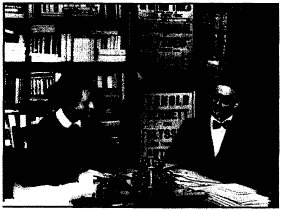
She decided to name her shop Shakespeare and Company. She knew that William Shakespeare, father of English literature, would approve of her plan to encourage the company of people who loved to read. Beach added Shakespeare to her collection of pictures, hanging a portrait of him on a cast-iron hook outside the door.
The bookshop was not the most efficient business. There was no card catalog for the library. Books were in no particular order and had no marked price, but before long travelers and expatriates1ŌĆöauthors, composers, and paintersŌĆöcrowded Shakespeare and CompanyŌĆÖs rooms. Some were already famous; others, such as Ernest Hemingway, were unknown in 1919. In time, they saw their own books through Shakespeare and CompanyŌĆÖs windows, and Beach added their pictures to her walls.
Some expatriates did not stay in Paris long, so they used Shakespeare and Company as a gathering place and a post office. Beach also relayed messages, lent money, and listened sympathetically to her customers. Expatriate Irishman James Joyce, one of her favorite customers, even convinced her to publish his mast famous book, Ulysses.
By 1939, war again threatened the Continent. Most Americans left Europe, but Beach was determined to stay in Paris. The shop remained open despite the German occupation of the city in June 1940, but fewer customers came.
One December day in 1941, a German officer threatened to seize BeachŌĆÖs shop. Within hours, she and three helpers carried thousands of books and letters to safety. They took down the shelves and ShakespeareŌĆÖs portrait from the cast-iron hook above the door. It was as if the bookshop had never existed.
1expatriate: a person who has taken up residence in a foreign country


Beach did not reopen Shakespeare and Company after the war. The building became an antique store and is now an import/export store for Chinese goods.
If you go to Paris today, you will find a small shop along the Seine (a famous French river) with a sign that reads ŌĆ£Shakespeare and Company?ŌĆÖ Inside the picture-lined walls (Beach is there), owner George ŌĆśWhitman will fetch you a used book in English among the disorderly floor-to-ceiling shelves. Some of his customers are writers; others hope to be. Speaking EnglishŌĆöwith accents from around the worldŌĆöthey chat about books and art.
If you leave Shakespeare and Company that day feeling as if
you are part of a new club, you will understand how Sylvia
BeachŌĆÖs expatriates felt seventy years ago.
Ernest Hemingway, Beach, and two friends (from right to left) pose for a photo outside Shakespeare and Company in March 1928. Hemingway signed this photo (his signature is in the bottom right corner) and drew a line to point out his bandaged head.
Page T-26
Complete the chart with words or phrases that describe Sylvia BeachŌĆÖs character. Identify information from the article that supports each character trait.
Character Trait
|
Supporting Information
|
|
|
|
|
|
|
How did Sylvia Beach feel about literature and books? Explain your answer using details from the article.
Back to top
Go On
Page T-27
Page T-27
Back to top
The Things That HavenŌĆÖt
Back to top
Been Done Before
Back to top
Edgar Guest
The things that havenŌĆÖt been done before,
Those are the things to try;
Columbus dreamed of an unknown shore
At the rim of the far-flung sky
And his heart was bold and his faith was strong
As he ventured in dangers new,
And he paid no heed to the jeering throng
Or the fears of the doubting crew.
The many will follow the beaten track
With guideposts on the way.
They live and have lived for ages back
With a chart for every day.
Someone has told them itŌĆÖs safe to go
On the road he has traveled oŌĆÖer,
And all that they ever strive to know
Are the things that were known before.
A few strike out, without map or chart,
Where never a man has been,
From the beaten pats they draw apart
To see what no man has seen.
There are deeds they hunger alone to do;
Though battered and bruised and sore,
They blaze the path for the many, who
Do nothing not done before.
The things that havenŌĆÖt been done before
Are the tasks worthwhile today;
Are you one of the flock that follows, or
Are you one that shall lead the way?
Are you one of the timid souls that quail
At the jeers of a doubting crew,
Or dare you, whether you win or fail,
Strike out for a goal thatŌĆÖs new?
Page T-28
What is most likely the poetŌĆÖs purpose in writing this poem? Use ideas from the poem to support your answer.
N
S
Go On
Page T-29
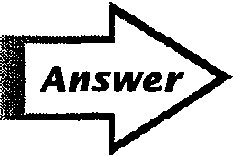
Back to top
Planning Page
You may PLAN your writing for Number 33 here if you wish, but do NOT write your final answer on this page. Your writing on this Planning Page will NOT count toward your final score. Write your final answer beginning on the next page.
Back to top
Page T-30
Page T-30
33
Choose a line or lines from the poem. Discuss the meaning of your selection, and explain how it applies to Sylvia Beach. Use ideas from BOTH the poem and the article in your answer.
In your answer, be sure to include
In your answer, be sure to include
Ę the line or lines you have selected from the poem
Ę
the line or lines you have selected from the poem
Ę an explanation of how your selection applies to Sylvia Beach
Ę
an explanation of how your selection applies to Sylvia Beach
Check your writing for correct spelling, grammar, and punctuation.
Back to top
Go On
Back to top
Page T-31
Back to top
Page T-32
Planning Page
You may PLAN your writing for Number 34 here if you wish, but do NOT write your final answer on this page. Your writing on this Planning Page will NOT count toward your final score. Write your final answer beginning on the next page.
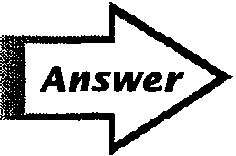
Write an essay about a person in history or someone you know who has overcome obstacles to follow a dream or fulfill an ambition.
In your article, be sure to include
In your article, be sure to include
Ę who the person is
Ę
who the person is
Ę what he or she did
Ę
what he or she did
Ę the challenges he or she faced
Ę
the challenges he or she faced
Ę
how the challenges were overcome
Ę an introduction, a body, and a conclusion
Ę
an introduction, a body,
and a conclusion
Check your writing for correct spelling, grammar, and punctuation.
Back to top
Go On
Page T-35
Back to top
Page T-36
STOP
Page T-37
SCORING GUIDE
SCORING INFORMATION
In the operational test, the multiple choice questions will be scored using an answer key. The open ended items will
be
clustered together and scored using four rubrics:
- Listening/Writing
- Reading/Writing
- Independent Writing
- Writing Mechanics
You will be unable to accurately ŌĆ£scoreŌĆØ the sample test items because you will not have all the necessary tools such as final rubrics, range finders, and student anchor papers. We recommend instead that you sort your student papers according to the rubrics presented here into three groupsŌĆöhigh, medium, and low.
REVIEWING STUDENT RESPONSES
REVIEWING STUDENT RESPONSES
ReadingŌĆöSession 1
ReadingŌĆöSession
1
Using the answer key, determine the number of correct responses to the multiple choice questions.
SCORING GUIDE
Listening/WritingŌĆöSession 1
Listening/WritingŌĆöSession 1
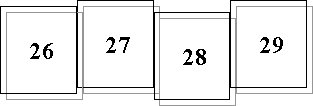
Using the Listening/Writing rubric, review Numbers 26, 27, 28, and 29 (the graphic organizer, the two short response questions, and the extended response question) together.
Reading/WritingŌĆöSession 2
Reading/WritingŌĆöSession
2
Using the Reading/Writing rubric, review Numbers 30,31,32, and 33 (the graphic organizer, the two short response questions, and the extended response question) together.
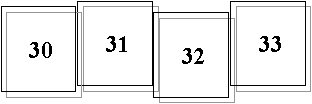
Independent WritingŌĆöSession 2
Independent WritingŌĆöSession 2
Using the Independent Writing rubric, review Number 34 (the independent writing extended response) alone.

Writing MechanicsŌĆöSessions 1 and 2
Writing MechanicsŌĆöSessions 1 and 2
Using the Writing Mechanics rubric, review Numbers 29, 33, and 34 (all three extended responses, including the independent writing extended response) together.
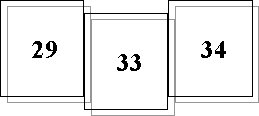
10
ABOUT THE RUBRICS AND SAMPLE RESPONSES
ABOUT THE RUBRICS AND SAMPLE RESPONSES
Listening/Writing and Reading/Writing Rubrics
The top
part of the Listening/Writing and the Reading/Writing rubrics is a general rubric that can be used to assess any written response to literature. The boxed text is a specific rubric about
the individual passage or set of passages to which the student is responding.
Independent Writing Rubric
Independent Writing Rubric
The general rubric for independent writing is used to assess the independent writing-extended response for writing style and content.
Writing Mechanics Rubric
Writing Mechanics
Rubric
The general rubric for writing mechanics is used to assess all three extended response questions for writing mechanics only.
Sample Responses
Sample Responses
Sample student responses follow each rubric The sample responses are annotated and illustrate the top score level] of performance for each rubric.
| Session 1: Reading
|
| Use the Answer Key to determine the number of correct responses to the multiple choice question.
|
| Session 1: Listening/Writing
|
| Use the Listening/Writing rubric to review Numbers 26, 27, 28, and 29 together.
|
| Session 2: Reading/Writing; Independent Writing
|
Use the Reading/Writing rubric to review Numbers 30, 31, 32, and 33 together.
Use the Independent writing rubric to review Number 34 alone.
|
| Session 1 and 2: Writing Mechanics
|
| Use the Writing Mechanics rubric to review Numbers 29, 33, and 34 together.
|
11
ANSWER KEY FOR MULTIPLE CHOICE QUESTIONS
- A
- J
- C
- F
- D
- F
- A
- G
- D
- F
- D
- H
- B
- G
- C
- F
- C
- H
- D
- G
- B
- H
- B
- F
- D
12
RUBRICS AND SAMPLE TOP
SCORE RESPONSES
LISTENING/WRITING RUBRIC FOR NUMBERS 26, 27, 28, 29
LISTENING/WRITING RUBRIC FOR NUMBERS 26, 27, 28, 29
6
Taken as a whole, the responses
Ę
fulfill the requirements of the tasks
Ę
address the theme or key elements of the text
Ę
show an insightful interpretation of the text
Ę
make connections and demonstrate reflection
Ę
make effective use of relevant and accurate examples from the text
Ę
develop ideas fully with thorough elaboration
In addition, the extended response
Ę
establishes and maintains a dear focus
Ę
shows a logical, coherent sequence of ideas through the use of appropriate transitions or other devices
Ę
is fluent and easy to read, with vivid language and a sense of engagement or voice
Ę
is stylistically sophisticated, using varied sentence structure and challenging vocabulary
The 6-point responses demonstrate a thorough understanding of both essays. The graphic organizer is complete and accurate. Overall, the responses clarify the difference between the traditional native way of life that is still alive for Peggy Yazzie and Buffalo Bird WomanŌĆÖs feeling that the old ways are ŌĆ£gone forever.ŌĆØ The student may respond to Number 28 by writing, ŌĆ£Many things have changed for Buffalo Bird Woman. She used to live using traditional Indian waysŌĆöin an earth lodge, cooking over an open fireŌĆöbut now she lives like the white man does, in a house with chimneys, cooking on a stove.ŌĆØ The extended response accurately describes and compares both womenŌĆÖs memories and explains how those memories have affected their lives.
5
Responses at this level demonstrate most of the characteristics of responses at the 6-point level, but the responses may show slightly less understanding, provide less elaboration, or lack the consistent quality of responses at the 6-point level.
The 5-point responses show evidence of an understanding of both essays, but the responses do not consistently include as much elaboration as the 6-point responses. The graphic organizer is essentially correct. The student may respond to Number 28 by writing, ŌĆ£Many things have changed for Buffalo Bird Woman. She used to live in an earth lodge, but now she lives in a house with chimneys.ŌĆØ
13
4
Taken as a whole, the responses
Ę
fulfill some of the requirements of the tasks
Ę
address some of the key elements of the text
Ę
show a predominantly literal interpretation of the text
Ę
make few connections
Ę
may be brief, with little elaboration, but are sufficiently developed to answer the questions
Ę
provide some examples and details from the text
In addition, the extended response
- is generally focused, though may contain some irrelevant details or minor inaccuracies
- shows a clear attempt at organization
- is readable, with some sense of engagement or voice
Ę
primarily uses simple sentences and basic vocabulary
The 4-point
responses
are
organized and
reflect a predominantly literal understanding of both essays. The graphic organizer is essentially correct. The short responses and the extended response may generalize or list facts from the essays without synthesizing-them to fully explain the views of Peggy and Buffalo Bird Woman. The student may write in response to Number 29, ŌĆ£They have different feelings about their memories,ŌĆØ without elaborating with supporting details from the essays. Conclusions may be reasonable and accurate but not supported by details from the essays.
2
3
Responses at this level are similar to responses at the 4-point level, but the responses may be weakly organized or sketchy, with ideas that are not supported by examples from the text. There may be a few minor inaccuracies, and the responses provide fewer details. The responses indicate that the student has read the entire text but experiences gaps in understanding the whole.
The 3-point responses indicate only a partial understanding of both essays. The graphic organizer may be correct or contain some inaccuracies. The short responses and the extended response may contain some accurate information, but they may be incomplete or include unsustained ideas.
14
2
Taken as a whole, the responses
Ę
fulfill some of the requirements of the tasks
Ę
address basic elements of the text
Ę
show little evidence that the student understood more than parts of the text
Ę
make few connections
Ę
may provide some ten-based examples and details
In addition, the extended response
Ę
may show an attempt to establish a focus
Ę
may contain some irrelevant or inaccurate details, along with correct information
Ę
is readable, with little sense of engagement or voice
Ę
uses minimal vocabulary
Ę
may indicate fragmented thoughts
The 2-point responses are readable but not truly logical. The responses may answer only parts of the questions, or may indicate misinterpretation of the questions, and may focus on only minor details. The graphic organizer will be incomplete or will contain inaccuracies. The short and extended responses may contain accurate details without making meaningful connections or drawing conclusions.
1
Responses at this level are more difficult to read and understand than responses at the 2-point level. The responses show evidence of comprehension of only parts of the text, and may be repetitive, focusing on minor details.
The 1-point responses are often very brief or repetitive, indicating that the student has understood only parts of the essays. The graphic organizer is inaccurate or incomplete. The short responses show some confusion, and the extended response is unfocused or focuses solely on minor details.
0
The responses are incorrect, irrelevant, or incoherent.
15
SAMPLE TOP SCORE RESPONSES
Using specific details from the essay, complete the chart below to show
what
Peggy Yazzie learned from each grandparent
SHI-MA-SANI
|
SHI-CHEEH
|
--fry bread
--raise sheep
--use mutton for food
|
-sing
-pray
-hand tremble
|
Why were the things Peggy Yazzie learned from her grandparents important to her?
How has life changed for Buffalo Bird Woman? Use details from the essay to support your answer.
Peggy was proud that she was able to learn things from her grandparents. This also helped her to feel closer with the Native American culture and way of life.
How has life changed for Buffalo Bird Woman? Use details from the essay to support your answer.
Life has changed for Buffalo Bird Woman because she no longer lives the Native American way of life. She lives in a house instead of an earthen lodge. She now lives true ŌĆ£white manŌĆÖs wayŌĆØ ŌĆō a totally different culture and lifestyle.
16
Discuss the memories of both Peggy Yazzie and Buffalo Bird Woman.
In your discussion, be sure to include
Ę
descriptions of their memories
Ę
a comparison of the types of memories they have
Ę
how each woman Is affected by her memories
Check your writing for correct spelling, grammar, and punctuation.
Both Peggy Yazzie and Buffalo bird Woman remember a different daily life, the Native American way. Buffalo Bird Woman remembers the Buffalo and the black tailed deer. She also remembers and can still imagine the sounds and sights of the village. Peggy Yazzie remembers the Native American way also. She remembers how her grandmother made her blouses, skirts, and did her hair. she remembers her grandfather making her buttons and jewels.
Both women remember their favorite things of a culture that they love.
Response continues on next page.
17
Continued from previous page.
They loved the way they lived their lives, and that is why they remember so much. Buffalo bird Woman no longer has her culture, and so she is forced to live in another. Peggy goes to Native American ceremonies, which brings her closer to her culture and childhood. Both women are different ages, and live in different ways, but they both have one thing in common, the love of the Native American way.
The responses demonstrate a thorough understanding of both essays, accurately describing the differences between Peggy YazzieŌĆÖs sense that the traditional way of life is still alive and-Buffalo-Bird WomanŌĆÖs feeling that the old ways are ŌĆ£gone forever?ŌĆÖ The graphic organizer contains details that show what Peggy Yazzie learned from both grandparents. In the first short response, the student makes a connection between what Peggy Yazzie learned from her grandparents and her feelings about her Native American heritage. In the second short response, the student recognizes the contrast between Buffalo Bird WomanŌĆÖs past and present way of life, using a relevant example from the text. The extended response focuses on the comparison of the womenŌĆÖs memories and explains how those memories have affected their lives, making connections beyond the text: ŌĆ£Buffalo Bird Woman no longer has her culture, and so she is forced to live in another. Peggy goes to Native American ceremonies, which brings her closer to her culture and childhood?ŌĆÖ ŌĆ£Both have one thing in common, the love of the Native American way?ŌĆÖ The response is fluid and easy to read, incorporating varied sentence structure.
NOTE: This set of responses represents a high-level score for the Listening/Writing rubric only, and might not be selected as top responses for either writing or writing mechanics.
18
The 6-point responses demonstrate a thorough understanding of the article and the poem and support that understanding with text-based details; the student understands both Sylvia BeachŌĆÖs character and the purpose of the poem (to convince or challenge the reader to be a leader or trailblazer) on a sophisticated level. The graphic organizer is complete and accurate, and the supporting information is appropriate and well chosen. The response to Number 31 continues to build a picture of Sylvia BeachŌĆÖs character by describing her passion for literature and books. In Number 32, the student accurately explains the poetŌĆÖs purpose in writing the poem, providing text-based support for the explanation. The extended response synthesizes information from the article and the poem by applying aspects of Sylvia BeachŌĆÖs character to the poetŌĆÖs ideas about people. For example, the student may compare the poetŌĆÖs ideas about people who ŌĆ£blaze the pathŌĆØ for others to the trailblazing nature of Sylvia Beach and her shop.
READING/WRITING RUBRIC FOR NUMBERS 30, 31, 32, 33
READING/WRITING RUBRIC FOR NUMBERS 30, 31, 32, 33
6
Taken as a whole, the responses
Ę
fulfill the requirements of the tasks
Ę
address the theme or key elements of the text
Ę
show an insightful interpretation of the text
Ę
make connections and demonstrate reflection
Ę
make effective use of relevant and accurate examples from the text
Ę
develop ideas fully with thorough elaboration
In addition, the extended response
Ę
establishes and maintains a dear focus
Ę
shows a logical, coherent sequence of ideas through the use of appropriate transitions or other devices
Ę
is fluent and easy to read, with vivid language and a sense of engagement or voice
Ę
is stylistically sophisticated, using varied sentence structure and challenging vocabulary
19
The 5-point responses show evidence of an understanding of the article and the poem; the student understands both Sylvia BeachŌĆÖs character and the poetŌĆÖs purpose but does not include as much elaboration as in the 6-point responses. The responses in the graphic organizer are essentially correct, but the supporting information may be brief or less convincing. The short responses are correct and draw appropriate conclusions but may not be elaborated as thoroughly as the 6-point responses. The extended response will include an explanation of aptly selected lines from the poem, but the conclusion as to how those lines reflect Sylvia BeachŌĆÖs character, although correct, may not be thoroughly connected to details from the text.
ŌĆś4
5
Responses at this level demonstrate most of the characteristics of responses at the 6-point level, but the responses may show slightly less understanding, provide less elaboration, or lack the consistent quality of the 6-point responses.
4
Taken as a whole, the responses
Ę
fulfill some of the requirements of the tasks
Ę
address some of the key elements of the text
Ę
show a predominantly literal interpretation of the text
Ę
make few connections
Ę
may be brief, with little elaboration, but are sufficiently developed to answer the questions
Ę
provide some examples and details from the text
In addition, the extended response
- is generally focused, though may contain some irrelevant details or minor inaccuracies
Ę
shows a clear attempt at organization
Ę
is readable, with some sense of engagement or voice
The 4-point responses are logical and for the most part accurate but reflect a predominantly literal or superficial understanding of the article and the poem. The graphic organizer is essentially correct, but the supporting information may be sketchy. The short responses may generalize, list details from the article and poem, or may not provide supporting information from the text. For example, the student may write ŌĆ£Sylvia cared about books:ŌĆÖ without elaborating with details from the article. The extended response may explain a line or lines from the poem and discuss some aspects of Sylvia BeachŌĆÖs character, but may not completely explain the relationship between those two pieces of information, or the student may draw conclusions that are reasonable and accurate but unsupported by details from the text.
Ę
primarily uses simple sentences and basic vocabulary
20
3
Responses at this level are similar to 4-point responses, but the responses may be weakly organized or sketchy, with ideas that are not supported by examples from the text. There may be a few minor inaccuracies and the responses provide fewer details. The responses indicate that the student has read the entire text but experiences gaps in understanding the whole.
The 3-point responses indicate only a partial understanding of the article and the poem; the student may draw some accurate conclusions about Sylvia BeachŌĆÖs character and the poetŌĆÖs purpose, but the responses will be brief or unsupported by information from the text. The graphic organizer may accurately list some of Sylvia BeachŌĆÖs character traits but omit supporting information. The short and extended responses may contain some accurate information, but the responses will be incomplete or include unsustained ideas. For example, the student may write in answer to Number 32, ŌĆ£The poet wanted to write about different kinds of people in the world.ŌĆØ In the extended response, the student may choose a quotation from the poem. The student may discuss aspects of Sylvia BeachŌĆÖs character, without making a connection to the quotation.
2
Taken as a whole, the responses
Ę
fulfill some of the requirements of the tasks
Ę
address basic elements of the text
Ę
show little evidence that the student understood more than parts of the text
Ę
make few connections
Ę
may provide some text-based examples and details
In addition, the extended response
Ę
may show an attempt to establish a focus
Ę
may contain some irrelevant or inaccurate details, along with correct information
Ę
is readable, with little sense of engagement or voice
Ę
uses minimal vocabulary
Ę
may indicate fragmented thoughts
The 2-point responses are readable but not truly logical. The responses may answer only parts of the questions, or may indicate misinterpretation of the questions, and may focus on only minor details. The graphic organizer will be incomplete or will contain inaccuracies. The short and extended responses may contain accurate details without making meaningful connections or drawing conclusions. For example, the student may write in response to Number 32, ŌĆ£The poet wanted to write about Columbus discovering America?ŌĆÖ The extended response may in part address both the poem and the article but will not draw a meaningful parallel between the poetŌĆÖs thoughts and Sylvia BeachŌĆÖs character.
1
21
1
Responses at this level are more difficult to read and understand than 2-point responses; the responses show evidence of comprehension of only parts of the text, and may be repetitive, focusing on minor details.
The 1-point responses are often very brief or repetitive, indicating that the student has understood only parts of the article and poem. The graphic organizer is inaccurate or incomplete. The short responses show some confusion, and the extended response is unfocused or focuses solely on minor details: ŌĆ£Sylvia liked books:ŌĆÖ
0
The responses are incorrect, irrelevant, or incoherent.
22
SAMPLE TOP
SCORE RESPONSES
Complete the digit with words or phrases that describe Sylvia BeachŌĆÖs character.
Identify information from the article that
supports
etch character trait.
Character Trait
|
Supporting Information
|
| Determined
|
Did not leave when war started; printed Ulysess
|
| inventive
|
Got the idea of our modern day library; made the shop interesting so that many people came
|
| Charismatic
|
Many people came to the shop; knew famous people.
|
How did Sylvia Beach feel ,about literature and
books?
Explain your answer
using details
hon. the snide.
Sylvia Beach felt that books and literature were essential to society. To help more people to read, she put a library in her shop so people who could not afford to buy the books could still read them.
What is most likely the poetŌĆÖs
purpose
in writing this
poem? Use ideas front the poem
to support your answer.
The poemŌĆÖs purpose is to get people to try new things ŌĆō to take risks. He says how ŌĆ£Columbus dreamed of an unknown shore. And he paid no heed to the jeering throng or the fears of the doubting crew.ŌĆØ He is saying to go along with what you believe in and you will go far.
23
Choose a line or lines from the poem. Discuss the meaning of your selection, and explain how it applies to Sylvia Beach. Use ideas from BOTH the poem and the article in your answer.
In your answer, be sure to include
- the line or lines you have selected from the poem
- an explanation of how your selection applies to Sylvia Beach
Check your writing for correct spelling, grammar, and punctuation.
The poem ŌĆ£The Things That HavenŌĆÖt Been Done BeforeŌĆØ, by Edgar Guest, relates to the owner of the bookstore/library, Sylvia Beach. The line that especially relates is this: ŌĆ£A few strike out, without map or chart, where never a man has been,ŌĆØ because Sylvia did what most women at the time were afraid to do ŌĆō go into business for themselves. She opened a bookstore in Paris, took a risk, and it ended up working out great! She took the path less traveled and ended up getting exactly what she wanted. By today, what she did is not all that uncommon, but when she did it, it was somewhere hardly any woman had been before. She truly traveled without a map, off the beaten track.
The responses demonstrate a thorough understanding of the article and the poem, supporting the understanding with details from the text; the student understands both Sylvia BeachŌĆÖs character and the purpose of the poem. In the graphic organizer, the student chooses words that describe Sylvia BeachŌĆÖs character and provides relevant, accurate details from the article: ŌĆ£Determined/Did not leave when war started?ŌĆÖ In Number 31, the student demonstrates insight by connecting Sylvia BeachŌĆÖs feeling for books with their value to society. In Number 32, the student identifies the poetŌĆÖs purpose, supporting this purpose with an example from the poem. The student goes on to make an insightful interpretation: ŌĆ£He is saying to go along wit what you believe in and you will go far?ŌĆÖ In the extended response, the student integrates ideas from both the article and the poem, weaving details to create a stylistically sophisticated response. The use of vivid language creates a strong sense of voice: ŌĆ£She truly traveled without a map, off the beaten track.ŌĆØ
NOTE: This set of responses represents a high-level score for the Reading/Writing rubric only, and might not be selected as top responses for either writing or writing mechanics.
24
INDEPENDENT WRITING RUBRIC FOR NUMBER
34
3
The response
Ę
fulfills the requirements of the task
Ę
demonstrates insight and makes connections
Ę
makes effective use of relevant and accurate examples to support ideas
Ę
develops ideas fully with thorough elaboration
Ę
establishes and maintains a clear focus
Ę
shows a logical, coherent sequence of ideas through the use of appropriate transitions or other devices
Ę
is fluent and easy to read, with vivid language and a sense of engagement or voice
Ę
is
stylistically sophisticated. using varied sentence structure and challenging vocabulary
2
The response
Ę
fulfills some of the requirements of the task
Ę
makes some connections
Ę
may be brief, with little elaboration, but is sufficiently developed
Ę
provides some examples and details, but may have difficulty in demonstrating how the examples relate to or support the ideas
Ę
is generally focused, though may contain some irrelevant details
Ę
shows a clear attempt at organization
Ę
is readable, with some sense of engagement or voice
Ę
primarily uses simple sentences and grade-level vocabulary
1
The response
Ę
fulfills few of the requirements of the task
Ę
makes few connections
Ę
may contain a few examples or details
Ę
may focus on minor details, or does not establish a focus
Ę
shows little or no organization
25
Ę
is often repetitive, with little or no sense of engagement or voice
Ę
uses minimal vocabulary
Ę
may indicate fragmented thoughts
0
The response is incorrect, irrelevant, or incoherent.
SAMPLE TOP
SCORE RESPONSE
Write an essay about a person in history or someone you know who has overcome obstacles to follow a dream or fulfill ambition.
In your article. be sure to include
Ę
who the person is
Ę
what he or she did
Ę
the challenges he or she faced
Ę
how the challenges were overcome
- an introduction, a body, and a conclusion
Check your writing for correct spelling, grammar, and punctuation.
The spindly and kindly old man wrapped in cloth called the ŌĆ£MahatmaŌĆØ achieved something no one else ever had: a nonviolent independence. His love for all men and perseverance had made it possible.
Mohandas Gandhi was a great reformer. He made India self sufficient. He did this by having the country people spin their own yarn instead of importing from Britain. He led marches against the viceroy, like the
Response continues on next page.
26
Continued from previous page.
Continued from previous page.
Salt march. People would come to him of all creeds and color when sad and he would support them. Often when the country was in trouble he would go on month long fasts until the viceroy would beg him to stop. They were friends. Eventually his pains led to the 1947 independence of India. But more problems would follow.
The Muslims and Hindus of India had been rivals for many centuries. After Independence pent up anger flared up. Some Muslims wanted independence. This caused Gandhi much anguish. He intermediated but the bloodshed continued. Eventually the Muslim state became Pakistan.
Response continues on next page.
Response continues on next page.
27
Continued from previous page.
Continued from previous page.
The struggle was over.
This tiny man made a great difference to his beloved country of India. His wisdom and religion helped the people through the turmoil. Because of him, the independence from Britain was nearly bloodless. He set precedents for many other leaders around the world who watched his feat of peace.
The response clearly focuses on a person in history who has overcome obstacles to follow a dream. The student demonstrates insight into the topic by connecting the events of GandhiŌĆÖs life with the impact those events had on India. ŌĆ£This tiny man made a great difference to his beloved country of India?ŌĆÖ The response is fully developed, with specific relevant details supporting the studentŌĆÖs view of Gandhi as a ŌĆ£great reformer?ŌĆÖ The introduction engages the reader, the body sustains and elaborates upon GandhiŌĆÖs position in history, and the conclusion is well stated. The student makes effective use of transitions throughout the response. The response goes beyond the requirements of the task by using vivid language to create dramatic effect: ŌĆ£The spindly and kindly old man wrapped in cloth...?ŌĆÖ
NOTE: This response represents a high-level score for the Independent Writing rubric only, and might not be selected as a top response for writing mechanics.
28
WRITING MECHANICS RUBRIC FOR NUMBERS
29. 33. 34
3
The writing demonstrates control of the conventions of written English. There are few if any errors, and none that interfere with comprehension. Grammar, syntax, capitalization, punctuation, and use of paragraphs are essentially correct. Any misspellings are trivial or repetitive; they occur primarily when a student takes risks with sophisticated vocabulary.
2
The writing demonstrates partial control of the conventions of written English. It contains errors that may interfere somewhat with readability but do not substantially interfere with comprehension. There may be some errors of grammar and syntax; however, capitalization, punctuation, spelling of grade-level words, and use of paragraphs are mostly correct.
1
The writing demonstrates minimal control of the conventions of written English. There may be errors of grammar, syntax, capitalization, punctuation, and spelling.
0
The writing demonstrates a lack of control of the conventions of written English. The errors make comprehension difficult; the writing may even be unintelligible.
29
SAMPLE TOP
SCORE RESPONSES
29
Discuss the memories of both Peggy Yazzie and Buffalo
Bird
Woman.
layout discussion, be
suit
to include
Ę
descriptions of their memories
-
a comparison
of the
types of memories they have
Ę
how each woman Is affected by her memories
Check your writing for coned spelling. grammar. and punctuation.
Both Peggy Yazzie and the Buffalo Bird Woman have memories of long ago. The Buffalo Bird Woman has memories of old and forgotten traditions. It makes her sad that they are gone Peggy Yazzie has memories of what her grandparents did for her. She is grateful for them.
The Buffalo Bird Woman remembers how she used to live in an earth lodge. She also remembers the sound of the warriors yelling. Peggy Yazzie remembers the things her grandparents taught her such as how to fry bread and how to pray and sing.
Peggy YazzieŌĆÖs memories make her feel grateful for all the things her grandparents did for her.
30
33
Choose a line or lines from the poem. Discuss the meaning of your selection, and explain
how it applies to Sylvia Beach. Use ideas front BOTH the poem and the article in your answer.
In your answer, be sure
to
Include
Ę
the line or lines you have selected from the poem
- an
explanation of how your selection applies to Sylvia Beach
Check your writing for correct spelling, grammar, and punctuation.
The inspirational poem, ŌĆ£Things That HavenŌĆÖt Been Done Before,ŌĆØ applies very well to Sylvia Beach. The poem emphasizes the importance of trying something new, and Sylvia Beach did just that.
One line of the poem particularly describes Sylvia Beach: ŌĆ£and his heart was bold and his faith was strong as he ventured into dangers newŌĆ”ŌĆØ Book shops didnŌĆÖt have card catalogs and werenŌĆÖt efficient, but Sylvia stuck to her dream.
Sylvia Beach is an inspirational person who tried something new. The poem describes her very well.
31
34
Write an essay about a person in history or someone you how who has overcome obstacles to follow
Ę
dream or fulfill an ambition.
hi your article, he sure to include
Ę
who the person is
Ę
what he or she did
Ę
the challenges he or she faced
Ę
how the challenges were overcome
Ę
an introduction, a body, and a conclusion
Check your writing for correct spelling, grammar, and punctuation.
Many people in history have followed a dream on fulfilled an ambition during the course of their lives. Among the venues in which they have accomplished these feats, Politics, Literature, and so on, there is no counting how many people have done it in sports. One of these people is Jim Abbott.
Jim Abbott is a major league pitcher who has fulfilled his dream of becoming a baseball player. In doing this he had one major challenge to faceŌĆöhe was born with only one hand. He overcame this with fierce determination and by wearing a specially designed
Response continues on next page.
Response continues on next page.
32
Continued from previous page.
Continued from previous page.
baseball glove which he wore over the area where his hand would normally be, and pitched the ball with the other. Even though he would not be able to bat, he still could pitch a baseball. Now Jim Abbott is an accomplished major leager who has pitched a no-hitter in his career and has shown the world that any dream you have can be made a reality, no matter what the obstacles.
Jim Abbott has overcome the obstacles to follow a dream. His ambitions were not surpressed by his deformity and certainly did not get in the way of his professional baseball career.
Taken as a whole, these responses are nearly error-free; grammar, syntax, capitalization, and punctuation are essentially correct.
33
Please fax Comment Sheets to (518) 486-1385 or mail this form to the New York State Education Department at the above address.
New York State Testing Program
New York State Testing Program
New York state Education Department, Room 671 EBA, Albany, NY 12234
Sample Test Comment Sheet
Grade 8 English Language Arts
1.
Content
Comments:
|
Are the questions generally appropriate in content?
|
YES
|
YES
WITH
EXCEPTIONS
|
NO
|
|
|
|
|
|
2.
Difficulty
Comments:
|
Are the questions generally appropriate in difficulty?
|
YES
|
YES
WITH
EXCEPTIONS
|
NO
|
|
|
|
|
|
3.
Directions
Comments:
|
Are the questions in the Sample Test Book clear and easy for students to follow:?
|
YES
|
YES
WITH
EXCEPTIONS
|
NO
|
|
|
|
|
|
4.
Format
Comments:
|
Is the format of the Sample Test Book satisfactory in terms of type size, space, arrangement of questions, etc.?
|
YES
|
YES
WITH
EXCEPTIONS
|
NO
|
|
|
|
|
|
5.
Time
Comments:
|
Were most of the students able to complete the sample test within the time allotted?
|
YES
|
YES
WITH
EXCEPTIONS
|
NO
|
|
|
|
|
|
Back to top
